I. Why Exercise is Crucial for Weight Loss
Regular exercise is an essential component of any successful weight loss plan. Not only can it help you burn calories, but it can also boost your metabolism and contribute to overall weight loss success. When combined with a healthy diet and lifestyle, exercise can help you achieve your weight loss goals and improve your overall health.

II. High-Intensity Interval Training (HIIT) Workouts
High-Intensity Interval Training (HIIT) is a form of exercise that combines short periods of intense effort with periods of rest or recovery. This type of workout has been shown to increase metabolism, maximize calorie burn, and promote fat loss.

Some popular HIIT exercises include sprint intervals, jumping jacks, and burpees. By performing these exercises at maximum effort for short intervals, you can challenge your body and burn more calories than traditional cardio workouts.
Relate: At home workouts: 22 No-Equipment HIIT Routines for Women of Every Fitness Level
Sample HIIT Routine
To get started with HIIT, try the following routine:
- Warm-up with 5-10 minutes of light cardio, such as jogging or jumping jacks
- Perform 30 seconds of each of the following exercises, with 10 seconds of rest in between:
1.Jumping jacks
Jumping jacks are a versatile and effective cardiovascular exercise that engages the entire body, promoting heart health, coordination, and endurance. This exercise is commonly included in warm-up routines and high-intensity interval training (HIIT) workouts.

How to Do:
1. Starting Position: Stand with your feet together, arms at your sides.
2. Jump and Extend Arms: Simultaneously jump while spreading your legs shoulder-width apart and raising your arms overhead. Your hands can touch at the top of the movement.
3. Land Softly: As you descend, lower your arms and bring your feet back together to return to the starting position.
4. Repetition: Continue the fluid motion of jumping and extending your arms for the desired duration or number of repetitions.
5. Breathing: Inhale as you jump and exhale as you return to the starting position.
Tips:
Maintain a brisk pace to elevate your heart rate.
Land softly to minimize impact on your joints.
Keep your core engaged throughout the exercise.
2.Squats
Squats are a fundamental and highly effective compound exercise that engages multiple muscle groups, including the quadriceps, hamstrings, glutes, and core. This versatile movement not only builds strength but also enhances lower body muscle tone and flexibility.

How to Do:
1. Starting Position: Stand with your feet shoulder-width apart, maintaining a straight posture, and keeping the weight centered on your heels.
2. Descend into Squat: Lower your body by bending at the knees and hips, pushing your buttocks back as if sitting into an imaginary chair. Ensure your knees do not extend beyond your toes.
3. Maintain Neutral Spine: Keep your back straight, chest up, and shoulders back throughout the movement. Engage your core to stabilize your torso.
4. Depth of Squat: Descend until your thighs are parallel to the ground, or as far as comfortably possible while maintaining good form.
5. Push Through Heels: Push through your heels to ascend back to the starting position, fully extending your hips and knees.
6. Breathing: Inhale as you lower into the squat, and exhale as you rise back up.
Related: Squat exercises at home for women: Shape curves with 7 exercises from basic to advanced
3.Push-ups
Push-ups are a classic and effective upper body exercise that targets the chest, triceps, shoulders, and core muscles. This versatile bodyweight exercise can be modified to suit individual fitness levels, making it accessible for beginners while still challenging for advanced practitioners. Consistently incorporating push-ups into your routine can enhance overall upper body strength and muscle tone.

4.Mountain climbers
Mountain climbers are a dynamic and effective full-body exercise that targets the core, shoulders, arms, and legs. This exercise not only builds strength but also enhances cardiovascular endurance and agility. Mountain climbers are often incorporated into high-intensity interval training (HIIT) routines for a powerful calorie-burning workout.

How to Do:
Starting Position: Begin in a plank position with your hands placed directly under your shoulders, arms fully extended, and your body forming a straight line from head to heels.
Drive Knees In: Lift your right knee towards your chest while keeping your core engaged. Aim to bring your knee as close to your chest as possible.
Return to Plank: Quickly switch and extend your right leg back to the starting plank position.
Alternate Legs: Repeat the movement with your left leg, driving the knee towards your chest and then extending it back to the plank position. Continue to alternate legs in a fluid motion.
Maintain Pace: Perform the exercise at a moderate to fast pace, maintaining a steady and controlled rhythm.
Breathing: Inhale as you bring each knee towards your chest, and exhale as you extend your legs back.
Core Engagement: Keep your core tight throughout the exercise to stabilize your body and engage your abdominal muscles.
Rest for 1-2 minutes, then repeat the circuit 3-4 times
Cool down with stretching exercises
Remember to listen to your body and modify the workout as needed. You can increase or decrease the length of your intervals or adjust the intensity of your exercises to suit your fitness level.
III. Resistance Training and Weight Loss
If you’re looking to lose weight, don’t underestimate the power of strength training. Resistance exercises like weightlifting, push-ups, and squats can help you build lean muscle mass, which in turn increases your metabolism and helps your body burn more fat, even at rest.
If you’re new to resistance training, start with light weights and focus on proper form to avoid injury.

Research has shown that resistance training can be more effective for fat loss than cardio alone. A study comparing the two types of exercise found that participants who did resistance training over 24 weeks lost an average of 1.8kg of fat, while those who did cardio lost only 1.3kg. Plus, strength training can help you improve your overall body composition, meaning you’ll have more muscle and less fat.
Benefits of Resistance Training for Weight Loss | |
Increases muscle mass and metabolism | Strength training helps you build lean muscle, which in turn increases your metabolism and helps you burn more calories even when you’re not working out. |
Promotes fat burning | Resistance exercises help your body burn fat more efficiently, reducing your risk of obesity and related health issues like diabetes or high blood pressure. |
Reduces risk of injury | Strength training can help improve your balance, flexibility, and posture, which can reduce your risk of falls or other injuries. |
Try incorporating resistance training into your workouts at least two to three times a week, focusing on compound exercises that work multiple muscle groups at once. This will help you get the most out of your workouts and promote overall weight loss success.
IV. The Importance of Flexibility for Weight Loss
Flexibility exercise is often overlooked but proves crucial for a successful weight loss plan. Incorporating flexibility exercises such as yoga or stretching can have numerous benefits that contribute to weight loss.
Firstly, flexibility exercises are great for enhancing overall fitness levels by increasing range of motion and improving muscular endurance.

Additionally, these exercises help improve posture, which can lower the risk of injuries during weightlifting exercises and improve body alignment, leading to a taller, leaner appearance.
Furthermore, engaging in stretching activities can aid injury prevention by improving muscle elasticity and joint mobility.
So, make sure to allocate time for flexibility exercises in your weight loss routine to reap the full benefits of your efforts.
V. The Power of Active Recovery
When following a 7-day exercise plan for weight loss, many may think that working out every day is the key to success. However, incorporating active recovery days into your routine is just as crucial for achieving your fitness goals. Active recovery refers to low-impact activities that allow your body to recover while still burning calories.
Some great examples of low-impact active recovery include:
- Walking or hiking
- Swimming or water aerobics
- Cycling or using a stationary bike
- Pilates or yoga
The benefits of active recovery are numerous. It can help reduce soreness and inflammation, prevent injuries, and improve circulation and flexibility. Additionally, active recovery can boost your overall mood and reduce stress levels.
By incorporating active recovery days into your 7-day exercise plan, you’ll give your body the time it needs to recover and recharge. This will help prevent burnout and keep you motivated to continue your weight loss journey. Remember, consistency is key, and even small steps can lead to significant progress over time.
VI. Fueling Your Body for Weight Loss
Proper nutrition and hydration are essential for successful weight loss. Here are some tips to help fuel your body:
Tip | Description |
Eat a balanced diet | Include healthy sources of carbohydrates, protein, and fat in your meals. Try to consume more fruits, vegetables, and whole grains. |
Control your portions | Avoid overeating by using smaller plates and measuring your food. This can help you eat less and feel more satisfied. |
Stay hydrated | Drink plenty of water and other low-calorie beverages throughout the day. Limit sugary drinks, alcohol, and caffeine. |
Remember to also fuel your body before and after your workouts. Eating a light snack like a banana or yogurt before exercise can give you energy, while a snack with protein and carbohydrates afterwards can aid in muscle recovery.
By following these tips, you can give your body the nutrients and energy it needs to support your weight loss goals.
Conclusion
Now that we have explored the importance of exercise, particularly HIIT workouts, resistance training, and flexibility exercises, as well as the significance of active recovery and proper nutrition, you are well-equipped to start your 7-day weight loss exercise plan.
Remember, success takes dedication and consistency. Don’t be discouraged by any setbacks or moments of weakness. Instead, focus on your progress and celebrate the small wins along the way.
With the right mindset and determination, achieving your weight loss goals is possible. So, lace up your sneakers, grab a water bottle, and start moving towards a healthier and happier you!
FAQ
Why is exercise crucial for weight loss?
Exercise is crucial for weight loss because it helps boost your metabolism, burn calories, and contribute to overall weight loss success.
What are high-intensity interval training (HIIT) workouts?
HIIT workouts are intense exercises that maximize calorie burn and fat loss. Examples of HIIT exercises include sprint intervals, jumping jacks, and burpees.
How does resistance training contribute to weight loss?
Resistance training, such as strength exercises, helps build lean muscle mass, increase metabolism, and promote fat burning.
Why is flexibility important for weight loss?
Flexibility exercises, like yoga and stretching, enhance overall fitness, improve posture, and aid in injury prevention during weight loss efforts.
What is active recovery and why is it important?
Active recovery refers to low-impact activities like walking, swimming, or cycling that help your body recover while still burning calories. It is essential for weight loss and overall fitness.
How does proper nutrition and hydration impact weight loss?
Proper nutrition and hydration are crucial for weight loss. Balanced eating, portion control, and staying hydrated are important components of a 7-day exercise plan.



